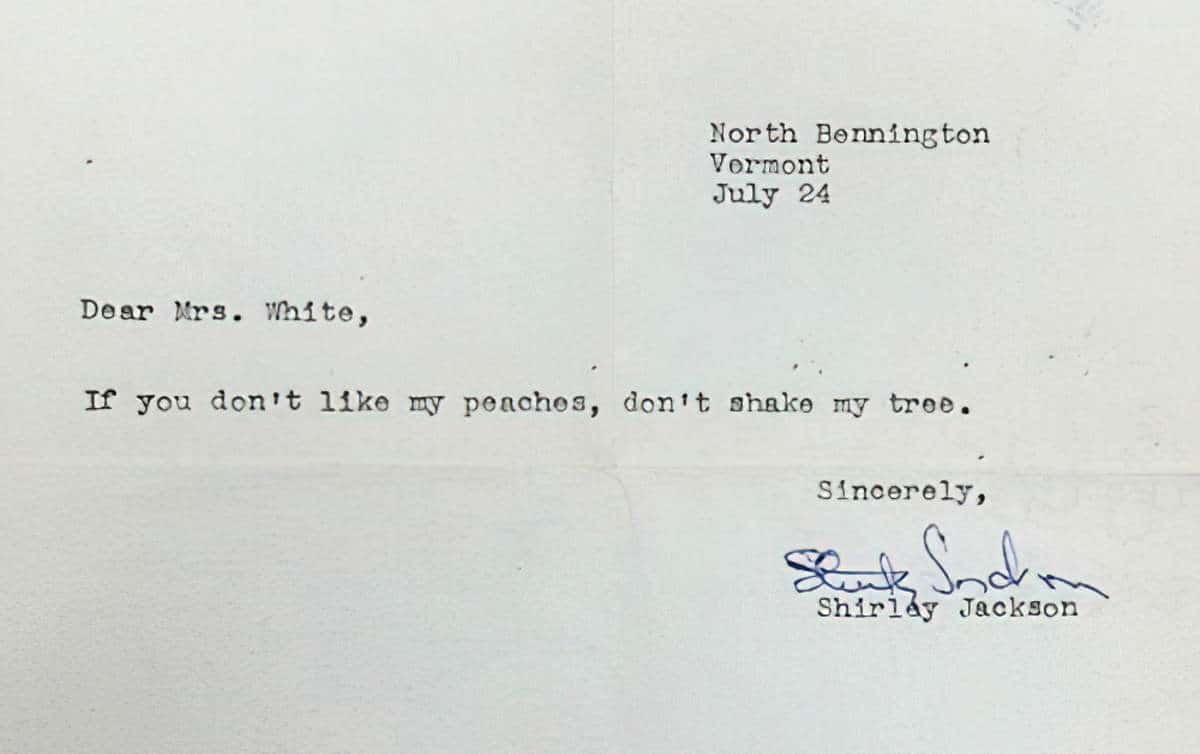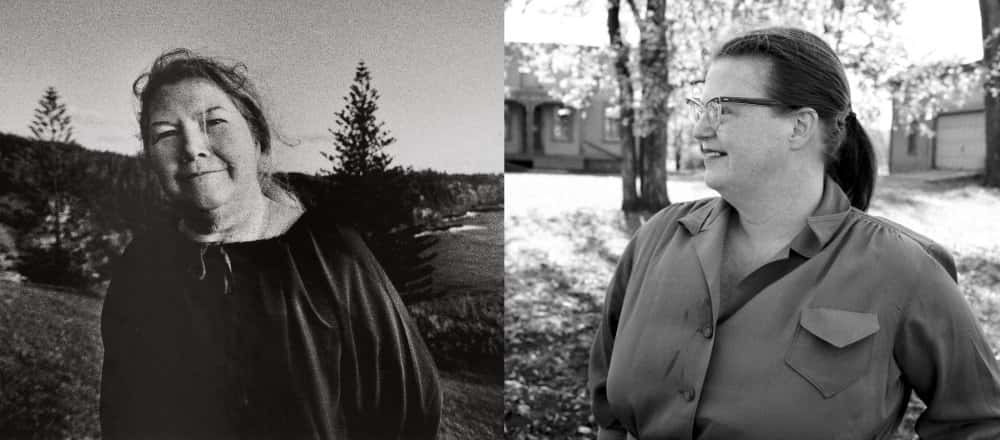Shirley Jackson did not only write disturbing supernatural stories. Her most famous short story is “The Lottery”.
She wrote short fiction, memoirs, non-fiction articles, plays and six finished novels. Her memoirs feature her family: “Life Among the Savages” and “Raising Demons,” which are warm and funny. Her published short stories comes to about 100 altogether.
[Jackson] writes about food preparation a lot, albeit incidentally, capturing some of the mundane banality that memory often keeps for no apparent reason.
consumer review of Hangsaman
SHIRLEY JACKSON’S LIFE IN A NUTSHELL
- Born in 1916 in San Francisco, raised in California
- Lived most of her adult life on the East Coast, in New York state and Vermont
- Married literary critic Stanley Edgar Hyman and married him in 1940 when she was 24.
- The couple moved to Bennington, Vermont.
- Shirley gave birth to four children.
- She is remembered as a raconteur and excellent hostess
- She also drank and smoke a lot, possibly self-medicating for her regular bouts of depression and anxiety. She also had agoraphobia.
- Jackson made a good living from her writing, and was one of the most commercially successful woman writers of her era.
- She wrote at least 1000 words per day while doing the housework, cooking and raising four kids. Writing was a welcome opportunity to sit down.
- Sylvia Plath loved her work. (You can see Jackson’s influence in The Bell Jar, specifically the influence of the Natalie Waite character from Jackson’s Hangsaman.)
- Unfortunately, as her mental health improved in the 1960s, her physical health deteriorated. She died of heart failure at the age of 48 while having a nap. It was 1965.
- Today, Shirley Jackson is far from forgotten. Her work experienced a comeback at the beginning of the 21st century. The applicable word is ‘marginalised’.
- Her books are sometimes banned from school libraries in conservative American states, as well as overseas (especially “The Lottery”)
SHIRLEY JACKSON: FEMINIST WRITER
She knows about girls and women, ho-nelly. From the mutual admiration to the whole frenemy thing which has always been mysterious me.
consumer review of Hangsaman

In the 1950s, Shirley Jackson was regarded as a decent writer of women’s experiences. (Women’s experiences are not seen as universal human experiences.) She was considered a feminist, which didn’t help her out.
She was arguably ignored and marginalised by prominent critics, which continues to this day. The writing life of Shirley Jackson reminds me of Australia’s Colleen McCullough ― both writers are enjoyed by the reading public but passed over for attention by specialised critics. (They even looked a little similar.)

More recently, though scholars specialise in the work of Shirley Jackson. She has been compared to Emily Dickinson. Dickinson also wrote about women in their twenties and thirties leading lives restricted by gender expectations. Dickinson’s characters also lost love and identity. Emily Dickinson was also an introvert shut-in:
“He marveled at the poetry of Emily Dickinson, sensing her kindred spirit. For the last seventeen years of her life, Dickinson rarely left her home in Massachusetts and spoke to visitors only through a partially closed door. “Saying nothing, ” she wrote, “sometimes says the most.”
Michael Finkel, The Stranger in the Woods: The Extraordinary Story of the Last True Hermit
Shirley Jackson’s understanding of feminist issues comes through in her work, but in many ways she went along with gendered expectations in her day-to-day life. For example, she was born in 1916. But she told people she’d been born in 1919 to appear younger than her husband. To be older than one’s husband remains a radical act. She understood how expectations of hypergamy worked and rolled with it.
In her stories, women consistently give the appearance of submitting to a man’s wishes. To help them survive real life, her characters frequently take refuge in imaginary worlds.
CHARACTERISATION
The 1950s gave rise to a new female archetype: The suburban madwoman. Makes historical sense. Women who refuse to settle happily for restricted roles have long been called ‘crazy’ as a means of control.
In Jackson’s stories, if imagination doesn’t work, next comes madness. Mental illness is one way to escape.
Jackson feminizes madness, creating autonomy outside of the restrictive social norms for women.”, “Hence, providing a space where her female characters produce disruptions to the patriarchal norms.”
L. Pearson 2008
Professor Angela Hague has said Jackson’s characters lack ‘a core identity [which] forces them to seek meaning and direction in the world outside themselves.’
Jackson wrote about:
- Disquieted mothers
- Discomfited wives
- Legendary demonic figures
- Characters in a broad range of socioeconomic circumstances
- Inequalities such as racism, anti-semitism and class bias are depicted in Jackson’s fiction
She can transport me into the mind of another, that even though disorienting is a rare delight despite hurtling towards our apparent demise.
consumer review of Hangsaman
Themes of isolation and alienation are common in Jackson’s work, often explored through characters who are outsiders or who are struggling with their own inner demons.
Jackson uses madness as a form of resistance, providing a space where her female characters produce disruptions to the patriarchal norms. (L. Pearson 2008)
Her female protagonists resist the established norms, verbally, physically, and psychologically, in order to create self autonomy. (L. Pearson 2008)
SETTING
Many of Jackson’s stories are set in domestic environments, exploring the horror and unease that can lurk beneath the surface of everyday life.
If Shirley Jackson’s settings don’t feel like places you’d like to go, that’s because life for women in the 1950s wasn’t an especially fun place to be. No financial independence, no control over her own body, diminished prestige outside very narrow, constricted feminised arenas. The 1950s were prison for women.
SHIRLEY JACKSON AND THE GOTHIC
Her work is often either explicitly Gothic or contains a strong interest in the sinister.
Andrew Smith 2009
Shirley Jackson’s fiction continues to be placed, within the gothic horror genre because of its supernatural and horror images.
L. Pearson 2008
North American writer Shirley Jackson defies categorization in the literary arena … arguments … have historically led critics to consider her exclusively a horror story author and, as a consequence, a forgotten writer.
G. Cohen 2012
The work of Shirley Jackson has often been misprised as vacuous tales of the supernatural and lighthearted examinations of domesticity.
Janise G. Roselle 2004
Jackson is known for subverting reader expectations, often setting up seemingly normal situations and then introducing elements of horror or unease.
The long critical neglect of Shirley Jackson has been successfully remedied, in part, by persuasive arguments for her place as a master of the American gothic, but this perspective has also unintentionally encouraged a somewhat limited view of her work. Though the gothic lens can be a complex and fruitful way to appreciate the depth of meaning in this author’s texts, it obscures other generic influences, especially that of mystery and crime fiction.
Ashley Lawson
While not always explicit, many of Jackson’s stories contain elements of the supernatural, adding to the sense of unease and horror.
THEMES
Thematically, Shirley Jackson didn’t venture to new ground.
- Evil on the inside, the appearance of good on the outside
- prejudice
- hypocrisy
- loneliness
- frustration
- people who have lost the ability to separate reality from non-reality
- what happens to people in the face of terror
As is the case with many authors, themes are not original; Jackson’s treatment of them is what makes her work original.
Jackson’s stories critique societal structures and traditions, suggesting that they have become corrupted over time and are used to punish people and invoke violence.
“Although it was not her first tale in print her literary career was effectively launched by the publication of her short story ‘The Lottery’ in The New Yorker in June 1948 which dealt with the inner tensions and murderously arbitrary rules of what otherwise appeared to be a ‘civilised’ community, and caused some considerable controversy at the time.”, “It is, however, only since the 1990s that critical interest in her work has flourished.”
Andrew Smith 2009
“The three-legged stool of the story represents the three pillars or legs of society: economics, politics, and religion.”, “However, over time, these systems have become corrupted by their leaders, so that rather than protecting their people, these structures of society are used to both punish their people and to invoke violence upon each other in the name of that tradition.”
Teresa Hakaraia 2019
Jackson’s writing makes specific references to different religions, including Judaism, Islam, and Christianity, as part of her social commentary.
[The Lottery] can be read as being anti-capitalist, anti-communist and anti-religious, most specifically making references to Judaism, Islam and Christianity.”, “The three-legged stool of the story represents the three pillars or legs of society: economics, politics, and religion.”
Teresa Hakaraia 2019
IRONY
Jackson likes to use ironic pictures to insinuate her criticisms. Her short story, “The Lottery” is a typical example of her use of irony.
“She is willing to shock readers with impressive and unforgettable scenes, and she likes to use ironic pictures to insinuate her criticisms.”, “Key words: Shirley Jackson; The lottery; Ironies and ironic figures”
Yuhan Zhu 2013
SYMBOLS AND MOTIFS
Fear of identification is a recurrent motif.
Shirley Jackson made explicit use of archetypes and quasi-mythical plots which tapped into a 1950s zeitgeist. Because her work appealed to ‘bored housewives’ in magazines such as Good Housekeeping, her adroit use of symbolism wasn’t studied seriously by people busy studying the exact same symbols and archetypes in work considered canon.
Her husband Stanley was an anthropologist and Shirley Jackson’s fiction is chockablock with motifs, language and imagery from the field of anthropology. “The Lottery” ends with a ritual stoning. Lord of the Castle is a dark fairy or folk tale. The Very Strange House Next Door
ENDINGS
INTENTIONAL AMBIGUITY
intentional ambiguity that prompts readers to question and wonder about the author’s intended meaning.
“When one discovers that Jackson admired William Empson’s, Seven Types of Ambiguities, in which he argues the best authors (such as William Shakespeare) purposely create ambiguities in their writing so that the reader questions and wonders what the author might have meant, one can begin to understand that there is more to Jackson than what critics have argued, and even she herself has said about the story.”, “It is clear that she had an admiration for Empson, as two years before ‘The Lottery,’ she wrote, ‘Seven Types of Ambiguity,’ in which Empson’s book is the coveted object of desire.”
Teresa Hakaraia 2019
TRUNCATED PLOTS
Shirley Jackson’s work is characterized by disunified and often truncated plots, the ultimate failure of her heroines, the lack of epiphanic moments, and the ultimate absence of salvation.
“Hattenhauer offers examples of proto-postmodernism in Jackson’s work by citing her disunified and often truncated plots, the ultimate failure of her heroines, the lack of epiphanic moments, and the ultimate absence of salvation.”, “To illustrate Jackson’s prescience, he applies John Barth’s theory of proto-postmodernism, which is a claim that some late modernist works prefigure postmodern tropes.”
Janise G. Roselle 2004
BOOKS ABOUT SHIRLEY JACKSON AND HER WORK
The standout books:
- Shirley Jackson by Lenemaja Friedman (1975) was the first major study, appearing a decade after Jackson’s death
- Private Demons by Judy Oppenheimer (1988), a biography
- Shirley Jackson: A Study of the Short Fiction by Joan Wylie Hall (1993), literary criticism
- Shirley Jackson: American Gothic by Daryl Hattenhauer (2003)
Just An Ordinary Day Short Stories
The header photo is created with artificial intelligence. Shirley Jackson never made it to her fifties, let alone her sixties, but perhaps in her dotage she would have looked a little like that?
